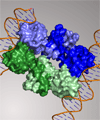April
Secrets of bacterial slime revealed

Newcastle University scientists have revealed the mechanism that causes a slime to form, making bacteria hard to shift and resistant to antibiotics.
When under threat, some bacteria can shield themselves in a slimy protective layer, known as a biofilm. It is made up of communities of bacteria held together to protect themselves from attack.
Biofilms cause dental plaque and sinusitis; in healthcare, biofilms can lead to life threatening and difficult to treat infections, particularly on medical implants such as catheters, heart valves, artificial hips and even breast implants. They also they coat the outside of ships and boats polluting the water.
Publishing in the Journal of Biological Chemistry, the team reveal how a molecular switch regulates biofilm formation. This new understanding could help identify a new target for antibiotics and prevent other biofilms from forming.
In order to thwart them from causing disease and biopollution, a Newcastle University team have been studying at the molecular level how bacteria form biofilms in the first instance.
They reveal how the master regulator of biofilm formation, a protein called SinR, acts in the model bacterium, Bacillus subtilis.
Richard Lewis, Professor of Structural Biology in the Institute for Cell and Molecular Biosciences who led the research said: “SinR is a bit like a rocker switch, a domestic light switch for instance. In the "down" position, when SinR is bound to DNA, the proteins required to make a biofilm are turned off and the bacteria are free to move. In the "up" position, SinR is no longer bound to DNA and instead interacts with other proteins, and the biofilms genes are turned on.”
SinR is a DNA-binding protein that acts to inhibit the expression of proteins required for the synthesis of the molecular glue that holds the biofilm together. The ability of SinR to bind to DNA is carefully controlled by a network of interactions with three other proteins. By the application of X-ray crystallography, the team have determined precisely how SinR interacts with very specific feature of its DNA target.
By understanding how the proteins interact with each other, and with DNA, scientists can look to develop molecules that interfere with these essential processes as a means to stop biofilms from forming.
Read more about work to combat biofilms by Newcastle University researchers in the press releases;
Tooth protection from the sea, A solution to sinusitis from the sea, Superbugs from space offer new source of power
Reference: Molecular Basis of the Activity of SinR, the Master Regulator of Biofilm Formation in Bacillus subtilis. Joseph A. Newman, Cecilia Rodrigues and Richard J. Lewis. The Journal of Biological Chemistry, Vol. 288, Issue 15, 10766-10778, April 12, 2013
Image shows: Structure of SinR bound to DNA. SinR inhibits the formation of the molecular glue that holds a biofilm together by binding to specific targets on DNA. These targets are spaced so that the DNA forms a loop around the protein.
published on: 12 April 2013
